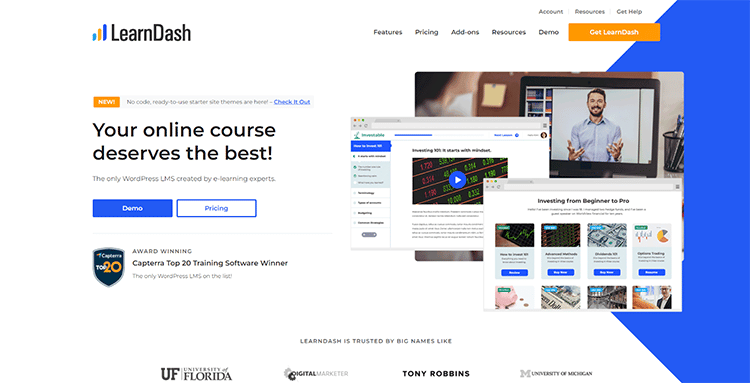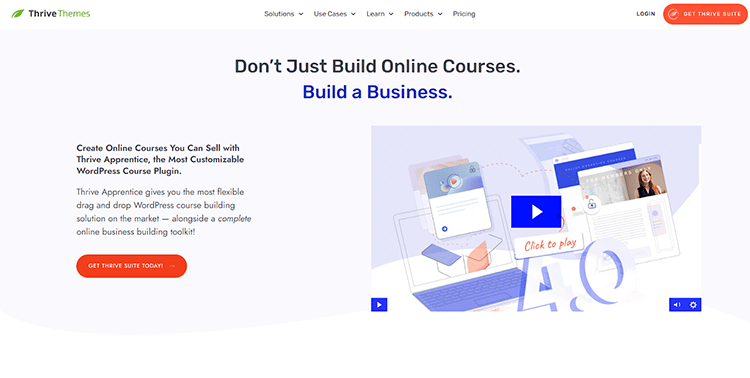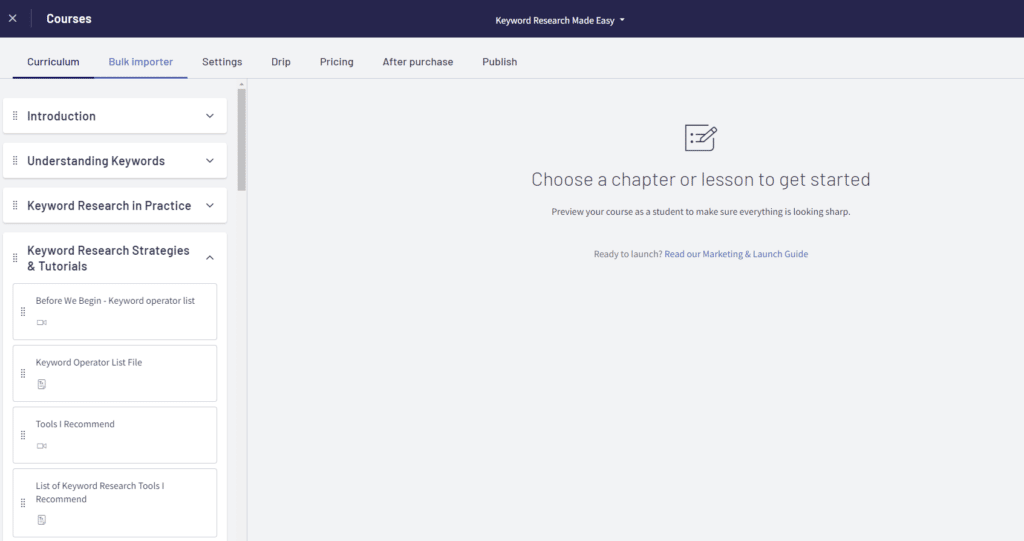The online course industry continues to grow at an unprecedented rate. Currently, the global eLearning market is worth over $200 billion, and experts estimate that it will increase to $375 billion by 2026.
This presents lucrative opportunities for creators with knowledge, skills, and experience to share.
If you’re ready to carve out a piece of that action for yourself as a course creator, then you’ll need a step-by-step process for selling online courses from your own website.
You need a reliable system that will allow you to get all the technical stuff done as fast as possible and with the fewest issues and dollars spent.
This article is written to help you learn how to sell online courses from your own website. But first, we’re going to take a look at why you would want to sell courses on your own site.
Why Would You Want to Sell Courses on Your Own Website?
With so many options for third-party online course platforms and marketplaces, you might be wondering why it’s necessary to sell courses from your own site.
There are a lot of reasons why course marketplaces may not be the best option for you. For instance, when using a platform like Udemy, you don’t own the brand, the platform, or the visitor traffic.
You only keep part of the revenue generated from your online course sales, you can’t engage with your learners. Furthermore, you have zero control over the website’s policies, such as the refund policy.
On the other hand, using your own website for selling your courses comes with a ton of benefits:
- You can maximize revenue by setting your own prices.
- Keep more of your earnings (no transaction fees for course sales).
- Build and strengthen your own brand (as opposed to the course platform’s brand).
- Get a direct channel to your prospects and customers.
- Own your contact database – when using a course marketplace, the customers are theirs, not yours.
- Offer product bundles of digital and/or physical products to potential students.
As you can see, there are tons of advantages to using your own website to sell online courses. The best part is that the more control you have over all these different business elements, the less risk you’re likely to encounter.
Choosing the Right Platform To Sell Your Online Courses
When it comes to creating, marketing, and selling an online course, the platform and digital storefront you choose will play a huge role in your success. This is why choosing the best platform for your needs is crucial in learning how to sell online courses from your own website.
You have 3 options:
1. Self-Host: If you are a coding whiz, you can create your own membership portal that will house your course. You’ll also have to build checkout pages and connect them to a secure payment processor. Alternatively, you can hire a developer to do it for you. Either way, there’s a lot of investment required in terms of time or money.
2. Hosted Platforms: Popular course platforms like Thinkific, Podia, Teachable, and Udemy make it easy to create and sell online courses, but it’s important to realize that this ease comes at a cost. The fees for these hosted platforms erode your bottom line and you are often limited in how you can present your brand.
3. Selling on Your Own Website: This is arguably the best option because it allows you more control over your business so you can achieve higher profit margins. You can set it up so that you’re able to build high-converting landing pages, collect global payments, and deliver your online course content – all straight from your site.
It’s clear to see that a website is an ideal way to achieve success when selling an online course.
Fortunately, these days it’s extremely easy to create a course website, and there are online course platforms and plugins that you can use to bring your course to market in a way that sets you up for success.
Below, I’ve outlined examples of two popular platforms that you might consider using on your website.
Learndash

Learndash is the only WordPress Learning Management System (LMS) created by eLearning experts. This award-winning platform is trusted by many big names including the University of Michigan, Yoast, Social Media Examiner, and Keap.
The software is structured to maximize the delivery of course content, from courses and sections, to lessons, topics, assignments, certificates, and more.
You’ll be able to increase completion rates by providing your learners with an immersive learning experience.
This platform is built to grow with you and will help you sell more courses on your website while maintaining complete control over every aspect of your knowledge business.
Thrive Apprentice

Thrive Apprentice lets you create and sell online courses from your website. It’s a great DIY option for non-technical users who want an affordable solution that offers advanced features without having to learn how to code.
This customizable WordPress course plugin comes with a flexible drag-and-drop course builder that makes it easy for people of all skill levels to build beautiful courses.
The software also functions as a full membership solution, which means you can manage your courses, memberships, and students from one convenient dashboard.
Furthermore, it also comes with a complete business-building toolkit, Thrive Suite, which means you don’t have to worry about integrating any additional tools to run your online course business.
Remember; however you choose to sell your course on your website, it’s important that you use some type of online form builder to not only boost sales but also capture the information of your potential students as well.
How to Sell Courses on Your Own Website (Step-by-Step)
As previously mentioned, in order to learn how to sell online courses on your own website (and eventually sell them), you have two options available to you.
First, you can link to a third-party platform, like Thinkific, or Teachable.
Secondly, you can host all of your course content yourself – either by doing your own coding or using a simple self-hosted WordPress LMS plugin tool to get the functionality you need with as little complexity and cost as possible.
The latter is the best option if you already own a website and want to sell your courses from it. You can achieve this by following the steps below:
Step #1: Build Your Website and Landing Page
I’m assuming you already have a website from which you’ll sell your courses, but if you don’t then building one should be your first step.
You can use a course management software tool or plugin that also works as a website builder to build your eLearning platform.
These tools either come ready-made or clone scripts that have integrated features (basic and advanced) designed to accommodate all users, including tutors, admin, and learners on the same platform.
Build Your Website: Your website must be clean and modern. It should be easy to use, fast-loading, and SEO optimized. It’s also important that your site be customizable to match your branding. Fortunately, the best website builders offer all these features and more, even on the most basic packages.

Build Your Course Landing Page: With the website in place, you now need to build a conversion-optimized landing page for your online course. This page will act as the “storefront” for your online course. It should be attractive and compelling enough so your website visitors want “in”.

With a unique and professional-looking landing page for your course, you’ll be able to create a powerful first impression among your audience, making it more likely that your target learners will convert.
Fortunately, most website builders come with stunning templates that are expertly designed for a variety of industries and niches.
This way, you’ll be able to get your landing page published in a fraction of the time it would otherwise take you starting from scratch – and you’ll be able to do it even with zero design or copywriting skills.
Step #2: Build Your Online Course

Once your website and landing page are in place, you can get started building your online course.
Creating a well-structured online course is just as important to your success as building a high-performing eLearning website.
You must use the right tools that will allow you to easily put together your course with as little hassle as possible and provide an exceptional learning experience to your students.
This includes the ability to create a proper learning structure, build membership portals, download assets, host videos, etc. Your video hosting needs are particularly important to consider if you’re planning to sell video classes as the hosting costs can add up pretty quickly.
It’s a good idea to offer a combination of delivery methods for your course content. This is a great way to engage and motivate your learners so they keep their focus and attention on the content.
You can create different types of content, including:
- Video content
- Audio content
- eBooks
- PDFs
- Checklists
- Quizzes
… and much more.
Keep in mind that your audience will perceive a video-based online course as having a higher value and they’ll be willing to pay more to access premium video content as opposed to simple audios, PDFs, or other text-based resources.
Once your content is in place, you can now choose whether you want to deliver the entire content all at once so students can learn at their own pace, or if you want to use the drip approach where you spread out the course over days, weeks, or months. This gives students time to absorb the content more effectively before they move on to the next module.
Step #3: Accepting Payments
The next step in learning how to sell online courses from your own website involves setting up payment methods.
You need a safe and secure way of accepting payments on your website. You can choose from services like Stripe and Paypal that simplify the entire process in exchange for a small commission on each sale.
Just keep in mind that some payment processors are easier to use than others. They come with fewer rules and less complicated APIs which makes them perfect for non-technical users.
Some course plugins integrate with payment processors, allowing you to make payments seamless on your website.
Step #4: Market Your Course
Once everything is set up, the final step is to drive traffic to your offering. You need to start marketing your online course so you can get students to enroll.
The best course platforms have built-in marketing and sales tools and integrate with a variety of software apps to help you bring your course in front of your target learners.
This includes:
- Email Marketing Software: You can send targeted and personalized campaigns designed to get more of your subscribers to buy your courses.
- Sales Funnels: Build sales funnels on your website with just a few clicks using integrated tools like ClickFunnels.
- CRM Software: Track your customers easily with customer relationship management software.
- Mobile App: Some platforms let you create a mobile app for your learners so they can continue with lessons wherever they are.
- Community Building: You can create and grow a community around your topic using integrated tools for forums, groups, and other online community spaces.
One of the absolute best ways to generate interest in your online course is to create a blog and write articles on your course topic. Add links to send readers to your course page if they want to learn more.
You can also create a YouTube channel where you post videos that address specific pain points experienced by your target audience. You can then position your course as the perfect solution to help them achieve their goals.
Alternatively, you can use ads on Google or social media to drive targeted traffic to your offer and get more people into your sales funnel.
The best part is that all these different marketing channels can work together to form an even stronger strategy for selling an online course. For example, you can share your YouTube videos in your emails, on your blog, or on social media channels.
Positives of Selling Courses on Your Own Website
Below, we take a look at all of the positives of keeping everything on your own website.
- Full Control: Creating and selling online courses on your own site gives you full control over your products, marketing, and branding, as well as contact with your customers.
- Authority: Being able to use a customizable and branded website gives you the opportunity to stand out and establish yourself as an authority in your space.
- No Competition: On sites like Udemy, your course is positioned right beside your competitors which makes it hard to attract the attention of your target learners.
- No Price Wars: Since your course is the only one on your site, there’s no need to compete with anyone at “race-to-the-bottom” prices in order to stand out.
- Student Interaction: Your student data and contact information belong to you and you can interact with learners on your own terms.
- No Monthly Payments: Selling your course from your own website helps you avoid paying hefty transaction fees or monthly payments for using a third-party platform.
Most online course marketplaces limit your pricing strategy but when you sell online courses through your own website, you’ll have full control over your pricing, which means you have the ability to maximize your revenue.
You won’t have to pay someone else part of your earnings, and you won’t have to spend money on additional tools to build, launch, and sell your courses online.
Negatives of Selling Courses on Your Own Website
Although there are a lot of positives to selling courses on your own site, there are also some drawbacks to consider, including the following:
- Security: When selling courses from your own site, you have to stay on top of security threats and ensure that you have best practices in place to protect your course content, student data, and payment information at all times.
- Hosting Your Own Videos: Another negative to keeping everything on your site is the need to host all of your own video content. As previously mentioned, this can quickly become expensive if you offer a lot of videos in your course.
Conclusion
I hope this article on how to sell online courses from your own website has helped you understand why selling your online courses this way is the best solution for entrepreneurs and how you can go about setting up your system to ensure that you do so in a way that helps your business grow over time.
Are you ready to implement this simple process to start selling courses on your own website? Share your thoughts below!
